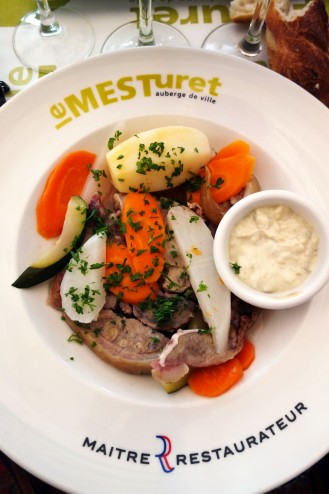We found classic French fare at a bistro named Le Mesturet, somewhere between the tourist-jammed Louvre complex and the more business-oriented Opera quarter. It’s a typical old-school Parisian spot with a small bar near the entrance, an intimate dining room with tasteful wooden furniture, a green awning over its doors, monogrammed china. All that good stuff.
Run by owner Alain Fontaine and his chef Régis Fève, Le Mesturet holds the title of Maitre Restaurateur, assigned by the state only to select restaurants that have proven their skill at preparing each plate from scratch using fresh, raw and often regional ingredients. This special appellation designates the establishment as one that can be trusted to cook the classics the proper way. And it sets places like Le Mesturet apart from all those crappy Parisian bistros…you know…
Bread is fresh, wine is carefully curated and sourced from all over France, the menu is the kind that makes you stop talking to focus better. Appetizers include things like grilled eggplant and goat cheese salad (which seems to be everybody´s favorite this summer), the very popular oeufs mimosa (a French take on deviled eggs) and their “suggestion of the day,” terrine of lightly cooked duck foie gras from Landes, Sauternes quince jam, peach chutney and brioche with Berry lentils. The names of regions their ingredients are sourced from are proudly displayed all throughout the menu. Duck is “Landes duck”, steak is from “Charolais beef”, the Guinea fowl hairs from Gers. Mains are nicely varied, each dish containing a different protein and each sounding wonderful enough to order without hesitation. But I was particularly interested in the “Grandmother’s Favorites” section of the menu. This is the type of grub I always seek.

To the surprise of my companions, I opted for the not-so-ladylike tête de veau, which is a calf’s head, this particular one rolled up in its own tongue and served with crisp steamed vegetables and Gribiche sauce. The dish is an old-school and quite conservative classic, one ordered by those who grew up after the war in a time when rationing and not wasting any part of an animal were the accepted norm. Only a handful of restaurants still offer it, partly because the whole head needed for the recipe is becoming increasingly difficult to find in Parisian markets and partly because it’s kind of a pain in the ass to prepare. Currently the dish has a small but very dedicated cult following. There’s even clubs and “brotherhoods” formed around a mutual appreciation for tête de veau.
It’s classically prepared by wrapping the head in its own tongue, covering it with a net and simmering the brainy bundle on low heat for hours in a court-bouillon (water, salt, white wine, carrots, onion and celery) flavored with a bouquet garni(bundle of fresh herbs) until the head flesh turns completely white. It’s then cooled, sliced into bits and presented with something fresh and something acidic to balance the fatty nature of the offal. This one was great, each bite an adventure. There was silken fat, jiggly bits of nose and ear, some cartilage, soft tongue. It all tasted very clean (despite what it actually is), since the innards sweat out the bad stuff while poaching in squeaky clean veggie broth. What meat there was (mostly cheek) was crumbly and tender, balancing out the crazier textures with its own proper beef consistency. The head was served with a mayonnaise-like emulsion called Gribiche, which was flavored with mustard, cornichons and capers. The mild heat of the mustard and the acidity of the pickled stuff smoothed out the very slightly murky flavor of the head, and the smooth, creamy texture of the sauce balanced the greasy gloss of the latter.
Lain carefully around the tête were the most delicate, perfectly cooked and vibrantly colored veggies – carrots, potatoes, zucchini and kohlrabi. They were steamed to a fantastic fork-tender and maintained a snap and firmness of texture, which provided a fantastic contrast to the jiggly, glossy, chewy slices of calf’s head. I’m rarely surprised or excited by steamed vegetables (roasted, maybe), but in this case they added a wonderful depth to the dish.
Two French boys ordered two blanquettes. Blanquette de veau is a bourgeois classic doubling as traditional comfort food best prepared by a loving French granny. It’s a creamy veal stew with tender mushrooms and baby onions served over rice pilaf. The meat is cooked in a “white stock,” flavored with the classic mirepoix of onions, carrots and celery. A roux is then made out of the cooking liquid and the meat is added back into it, along with some cream and egg yolk. Then come the onions and halved mushrooms. As this is considered a “white stew,” it’s not considered “proper” to serve it with anything that would add color, although this rule is sometimes broken by the addition of pees and carrots. Not in this recipe though. The menu clearly specifies there are no carrots in this blanquette.
Lunch at Le Mesturet is as much of a learning experience as a leisurely, lazy, satisfying meal. Traditional classics properly done, enjoyed in a bustling, intimate bistro.




